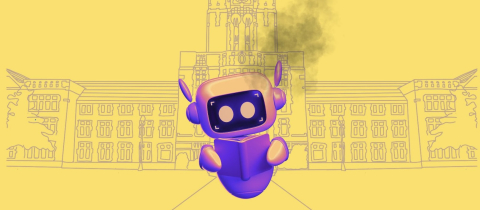Somewhere, in a laboratory, there is a mini-brain growing. In fact, mini-brains are growing in many laboratories all over the world. What do they dream of? Nothing at the moment, and nothing for the foreseeable future. They are only a few millimetres in size, comparable to a pencil’s eraser top. Consciousness still evades them.
And it’s not just brains. Intestines, ovaries, kidneys, even taste buds, are growing in three dimensions in laboratories, though their scale pales in comparison to the real stuff, and to call them mini-organs is overly simplistic.
They are officially designated as “organoids,” meaning “organ-like.” They are helping scientists better understand diseases and are already active participants in the much-hyped field of personalized medicine.
Step 1.5
Biomedical scientists need models in which to do experiments, especially when it comes to testing a new compound that could become a medical treatment. A drug candidate will first be tested in cells, then in an animal model like a laboratory mouse, and finally in human participants in the context of a clinical trial. But the non-human models preceding clinical studies, though useful, are imperfect. Cells grown in Petri dishes or culture flasks do not represent the organs they come from. They lack the necessary architecture. Moreover, organs are made up of many types of tissues, which themselves are made up of different types of cells. Meanwhile, cells in culture are of a single type. It’s a bit like creating a neighbourhood and filling it with iterations of the same house, over and over again, and pretending it looks just like a real city. Complexity and diversity are lost in the process. As for animal models, the fact that they are whole organisms is welcomed, but we are not giant rats.
Enter organoids as a sort of step 1.5, in between cultured cells and laboratory animals. Organoids grow out of stem cells. These stem cells may come from embryos or they may be adult stem cells, which assist our bodies in regenerating damaged tissue. They may also be fully differentiated cells—these are cells that have specialized their shape and function to play a singular role in the body, like a skin cell or a heart muscle cell—that scientists have induced into regressing to a stem cell state. Stem cells are, metaphorically speaking, like baby cells: they have the potential to specialize into one of many types of cells, just like an infant may one day become a cook, or a scientist, or an accountant. In creating organoids, stem cells become the specialized cells of an organ and self-organize in the architecture of that organ. Importantly, whereas traditional cell culture is done on a flat surface so that cells create a single layer, organoids grow in three dimensions.
The organs of our body do not exist in a vacuum; their cells are surrounded by an extracellular matrix. In order to grow organoids in the lab, scientists typically embed stem cells inside of this matrix. A popular one is called Matrigel. It is a gelatinous mixture of proteins, like collagen, that is secreted by mouse cancer cells. The stem cells, lodged inside of this adhesive matrix, are spun around in their chamber. They divide and differentiate. They recreate some of the tissue architecture of familiar organs. To nudge them toward becoming a particular organ, scientists can add specific molecules into the mix that will act as signals telling the stem cells to, for example, become brain cells.
Organoids are not just scientific marvels. They can be put to some interesting uses. Right now, in the Netherlands, some patients with rare forms of cystic fibrosis can be treated based on how an organoid grown from their own cells behaves when exposed to different drugs. This is an example of personalized medicine and it can be a handy way of getting around the problem of running a clinical trial for a very rare disease, where the recruitment of enough participants would be extremely challenging. But even for more common diseases, like cystic fibrosis, different mutations can all result in the same disease, but response to treatment can vary wildly. Analyzing an organoid’s response to a drug can be a litmus test for how the patient will respond.
And the usefulness of this screening process is not limited to pre-existing drugs; newer drugs could be discovered this way as well. One of the big problems with drug discovery is that many promising pharmaceuticals in cell culture end up failing spectacularly when given to humans. By testing them in organoids, which are a closer match for the complexities of the target organ, researchers may be better able to tell if these promises hold up before going through the expensive process of recruiting human volunteers. Moreover, the safety of a drug could be better assessed early on by seeing how human organoids of the liver and kidney process it.
Another encouraging prospect for organoids is in the realm of transplants. Obviously, a four-millimetre piece of tissue grown in the lab cannot replace a full organ for a patient in need of transplantation. But in the case of metabolic diseases (like phenylketonuria or maple syrup urine disease), where all that is needed for normal function is enough healthy cells to produce an enzyme, the idea of grafting an organoid becomes interesting, especially when combined with CRISPR. The gene editing tool kit could correct a faulty gene in the cells extracted from a person, and these corrected cells could be allowed to grow into an organoid in the lab before being returned to their donor’s body. Case in point, liver organoids in mice have been shown to rescue liver failure. Given the shortage of matched donors for people in need of a transplant, being able to use their own cells for the procedure would be life-saving. Another advantage? Since a person would be both donor and recipient of the same graft, there would be no need, in theory, for drugs that suppress the immune system in order to avoid tissue rejection.
Beyond the clinic, organoids can help basic research into human biology and disease progression. For example, researchers managed to recreate what an invasive colon cancer looks like by taking mouse cells, driving them to grow into a colon organoid, and introducing mutations in genes that are known to be mutated in colon cancer. Cancer is due to an accumulation of mutations in key genes, and the researchers were able to see the cancer, not just as out-of-control cells growing on a Petri dish, but as organized tissue that looked like colon cancer under the microscope. Likewise, human development can be more easily studied using organoids given how difficult it is to access tissue from human embryos. Even species differences can be looked at under the light of organoids. And consciousness? Even though we are a far cry from seeing little brain organoids in the lab develop consciousness, the word “consciousnessoid” has already been coined.
All of this hype makes it appear as though we are on the cusp of a biomedical revolution. But while organoids are a neat step forward, a closer look at these tiny marvels reveals a lot of limitations that the lay press typically ignores or downplays.
Stuck in infancy
Stories about brain organoids can put into the reader’s mind the idea of a big brain sitting in a vat somewhere, but that would be a gross exaggeration. These mini-brains can only grow to about 4 mm in size because they lack blood vessels. Blood brings oxygen and nutrients to a biological tissue and removes waste products. Without it, oxygen and nutrients can diffuse from the surface and into the organoid, but only for about 0.4 mm. The organoid can organize its shape in such a way that diffusion can sustain a growth of a few millimetres, but dead cells start to accumulate beyond that limit and the organoid needs to be broken up and the process has to be started again. Organoids also lack immune cells and contact with nerve cells. They are, in a sense, pretty naked in their little chambers.
The extracellular matrix they are embedded in does provide structure and food, but that very matrix introduces a lot of variability into the equation, since it is the biological product of a living organism. No two matrices are alike, which means that no two organoids are alike. Reproducibility, so critical in scientific research, is a challenge.
And for all the drum-beating about using organoids to study diseases of aging, like Parkinson’s and Alzheimer’s, organoids have a youth problem. They get stuck in early development. At the moment, for example, human brain organoids can form into brain tissue that is equivalent to a 24-week-old brain, no older. And those squiggly folds at the surface of our brain—the peaks called gyri and the grooves called sulci—do not form in brain organoids. This may be because the brain tissue is simply too young. Scientists have tried to induce crinkling that would create these peaks and grooves, but so far, no luck.
Brain organoids are not the only type of organoids out there, but they may be the ones that create the most friction. One researcher who studies them noticed that some prospective cell donors actually opt out when they are told their cells could be used for brain organoid research. Even though these 4-mm bits of living tissue are not going to develop feelings or the ability to think and be aware of themselves any time soon, the idea of one’s stem cells growing into brain tissue in a lab somewhere can be a step too far for some people.
And then there is the more down-to-earth question of commercialization. If donated cells lead to the development of a patentable technology, does the donor benefit?
While these questions are being debated in the pages of academic journals, the hype pipeline—which includes the scientists themselves, their university’s public relations office, and reporters—will continue to turn mole hills into mountains. In 2018, headlines were abuzz with the story of researchers in California growing Neanderthal mini-brains in their lab. The truth, while still compelling, was much less phenomenal. Comparing our modern human DNA to that extracted from the bones of Neanderthals, scientists had found 200 genes with significant differences between the two species. They picked one. They took skin cells from an average person, coaxed them into regressing into a stem cell state, and using the CRISPR gene editing tool, they precisely changed one basepair—a single letter in the DNA molecule—from the version we have to the version found in Neanderthal bones in that one gene. These “Neanderthalized” stem cells then grew into a pea-sized brain organoid whose shape looked more like popcorn than the sphere our modern brain organoids grow into. They also noticed that the way in which neurons were connected to each other was different than what is typically seen in humans.
We are a long way from cavemen growing in vats and escaping into the wilderness.
Take-home message:
- Organoids are mini-organs that grow from stem cells in three dimensions in the laboratory
- Their current and potential uses include studying human biology and how diseases develop; testing drugs for whether they will be safe and effective in a particular patient; and discovering new pharmaceuticals
- Organoids are limited in their size (up to a few millimetres), constrained by a lack of blood vessels, nerves, and immune cells, and subject to variability from one organoid to the next due to the common use of a biological matrix for their growth







